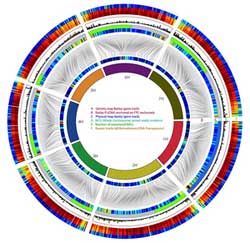A new future for an old crop: barley enters the genomics age

Barley gene space<br>
Source: Okayama University, Planning and Public Information Division
A Japanese team led by Kazuhiro Sato of Okayama University participates in the International Barley Sequencing Consortium (IBSC) to produce a high resolution assembly of the majority of barley genes.
The barley genome is almost twice the size of that of humans and determining the sequence of its DNA has proved to be a major challenge. This paper published in Nature is a detailed overview of the functional portions of the barley genome, revealing the order and structure of its 26,000 genes. The findings are also described in the January 2013 issue of Okayama University e-Bulletin: http://www.okayama-u.ac.jp/user/kouhou/ebulletin/index.html
First cultivated more than 15,000 years ago, barley is the world's fourth most important cereal crop both in terms of area of cultivation and in quantity of grain produced.
The barley genome is almost twice the size of that of humans and determining the sequence of its DNA has proved to be a major challenge. This is mainly because its genome contains a large proportion of closely related sequences, which are difficult to piece together.
A Japanese team led by Kazuhiro Sato of Okayama University participated in the International Barley Sequencing Consortium (IBSC). They succeeded in producing a high resolution assembly of the majority of barley genes in linear order.
By developing and applying a series of innovative strategies that allowed them to circumvent these difficulties, IBSC describes the location of dynamic regions of the genome that carry genes conferring resistance to diseases. This achievement also highlights the unprecedented detail in the differences (15 million positions) between a range of different barley cultivars. The report provides a detailed overview of the functional portions of the barley genome, revealing the order and structure of its 26,000 genes.
Access to the assembled catalogue of gene sequences will streamline efforts to improve barley production by breeding varieties that are better able to withstand disease and deal with adverse environmental conditions such as drought and heat stress.
Further information:
Okayama University
1-1-1 Tsushima-naka , Kita-ku ,
Okayama 700-8530, Japan
Planning and Public Information Division
E-mail: www-adm@adm.okayama-u.ac.jp
Website: http://www.okayama-u.ac.jp/index_e.html
About Okayama University
Okayama University is one of the largest comprehensive universities in Japan with roots going back to the Medical Training Place sponsored by the Lord of Okayama and established in 1870. Now with 1,300 faculty and 14,000 students, the University offers courses in specialties ranging from medicine and pharmacy to humanities and physical sciences. Okayama University is located in the heart of Japan approximately 3 hours west of Tokyo by Shinkansen.
Website: http://www.okayama-u.ac.jp/index_e.html
Journal information
・ Authors: The International Barley Sequencing Consortium
・ Title of original paper: A physical, genetic and functional sequence assembly of the barley genome.
・ Journal, volume, pages and year: Nature 491,711–716 (2012)
On line: http://www.nature.com/nature/journal/v491/n7426/full/nature11543.html
・ Digital Object Identifier (DOI): 10.1038/nature11543
・ Affiliations: Institute of Plant Science and Resources, Okayama University
・ Department website: http://www.rib.okayama-u.ac.jp
Media Contact
All latest news from the category: Agricultural and Forestry Science
Newest articles

Compact LCOS Microdisplay with Fast CMOS Backplane
…for High-Speed Light Modulation. Researchers from the Fraunhofer Institute for Photonic Microsystems IPMS, in collaboration with HOLOEYE Photonics AG, have developed a compact LCOS microdisplay with high refresh rates that…

New perspectives for material detection
CRC MARIE enters third funding period: A major success for terahertz research: Scientists at the University of Duisburg-Essen and the Ruhr University Bochum have been researching mobile material detection since…

CD Laboratory at TU Graz Researches New Semiconductor Materials
Using energy- and resource-saving methods, a research team at the Institute of Inorganic Chemistry at TU Graz aims to produce high-quality doped silicon layers for the electronics and solar industries….



